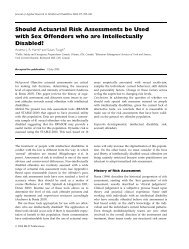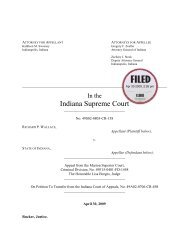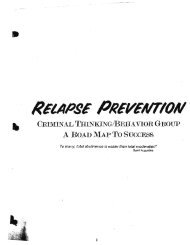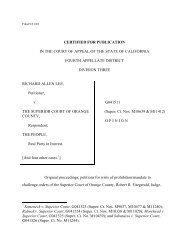Therapeutic Jurisp & Sexual Predator Laws - Defense for SVP
Therapeutic Jurisp & Sexual Predator Laws - Defense for SVP
Therapeutic Jurisp & Sexual Predator Laws - Defense for SVP
You also want an ePaper? Increase the reach of your titles
YUMPU automatically turns print PDFs into web optimized ePapers that Google loves.
For example, to satisfy its concerns that the predator law denied equal protection, the Washington SupremeCourt required that the law be revised to provide <strong>for</strong> a less restrictive placement in the community as isprovided in the state's general commitment law. n231 The majority concluded: "We there<strong>for</strong>e hold thatequal protection requires the State to comply with provisions of RCW 71.05 [Washington's generalcommitment law] as related to the consideration of less restrictive alternatives." n232 The generalcommitment law allowed the decision-maker to commit an individual to a community placement ratherthan to hospital. n233Rather than revise the law to allow predators to be committed initially to a less restrictive alternative, thelegislature, at the request of prosecutors, simply changed the definition of a sexually violent predator to bean individual who was too dangerous to be committed to a less restrictive community placement. n234This revision allows the jury only the stark choice of committing an individual to the SCC or releasingthem with no supervision or control in the community. It seems fair to conclude that juries will almostalways err on the side of safety and commit. n235 In addition to creating powerful incentives <strong>for</strong> juries tocommit, the state has saved itself the cost of providing a less restrictive community placement-the verycomponent whose absence Dr. Quinsey called a "fatal flaw" in the law. n236 [*409]G. Effect on Public PolicyBecause of the violent crimes that precipitated enactment of the Washington predator law and the resultingoutpouring of public rage, n237 public policy in Washington state, and probably in every state in theUnited States, considers sex offenders to be extremely dangerous n238 (as a group they are not n239 )and to be a high priority in public policy <strong>for</strong>mulation. n240 Legislatures across the country have beenenacting harsh measures to punish sex offenders and to prevent them from committing new crimes. n241These include mandatory registration <strong>for</strong> sex offenders, community notification laws that allow or requirelaw en<strong>for</strong>cement authorities to notify neighbors that a sex offender is living at a specific address, n242 andmandatory chemical castration laws that require the administration of certain sex-drive reducing drugs tosex offenders as a condition of their release from prison. n243Enactment of these harsh measures manifests an abrupt shift in American penology. Public policy nolonger strives to help the individual offender change <strong>for</strong> the better. Rather, sex offenders, like many othercriminals, are now simply considered part of a particular dangerous group that poses a long-term threat tocommunity safety. n244 As members of a group, they share the characteristics of their group. Risk ofrecidivism is measured primarily by actuarial techniques based on these characteristics, n245 and riskmanagement is paramount. n246 There is no expectation that offenders, especially sex offenders, can berehabilitated, and incapacitation <strong>for</strong> the more dangerous groups is the primary goal of the criminal [*410]justice system. As Professor Simon so poignantly puts it, "The new penology is agnostic toward treatment.The goal is waste management." n247In upholding the Kansas predator law, the Court emphasized that the government could exercise its policepower to civilly commit individuals who suffered from a mental abnormality that made them dangerouseven if they could not be treated. n248 Professor Simon puts it this way:The centrality of treatment under previous readings of the Due Process Clause made the constitutionality ofconfinement turn on the institutional priority of treatment and treatment professionals (i.e. those with agrounding in <strong>for</strong>ms of knowledge and power independent of the penal system). In Hendricks, treatment hasbeen reduced to a gesture. n249This decision may have important consequences <strong>for</strong> future public policy. It indicates that civil commitmentneed not have a therapeutic goal; mere incapacitation without any ef<strong>for</strong>t to improve the individual'scondition is acceptable. n250 It necessarily depreciates what the common law termed the parens patriaepower of state, which allows the government to commit individuals because they are unable to makeresponsible self-regarding decisions and need help. n251
















